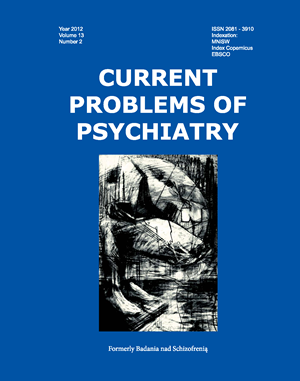Narcissism versus mobile phone addiction in women
Keywords:
narcissism, mobile phone addictionsAbstract
The aim of the study was to answer the following research problems:
- Whether and what differences exist between women at risk and those not at risk of addiction to mobile phone in range of narcissistic traits?;
- Whether and which narcissistic traits are predictors of addiction to mobile phone in women?
Material and methods. The research group consisted of 50 women, whose average age was 28 years. The following methods were used in the study: The Survey form and Mobile Phone Addiction Assessment Questionnaire developed by Potembska and Pawłowska and the Narcissism Inventory by Deneka, Hilgenstock, Müller.
Results and conclusions.
Women at risk of mobile phone addiction as compared to the individuals who were not at risk, were characterized by more severe: sense of helplessness, worthlessness, lack of sense of life, sense of doubt, discouragement and desire to escape from reality into dreams.
Addiction to mobile phone, preference for communicating by mobile phone to "face to face" contacts, looking for acceptance and closeness by means of phone calls and sent and received text messages, are best explained by intense need to escape from reality in symbolic world of dreams and search for security and support.
The best predictor of addiction to mobile phone conversations and text messaging is the intensified sense of helplessness, senselessness, doubt, discouragement, emptiness and lack of sense of life, which are compensated by the sense of exceptional physical attractiveness, having extraordinary organization skills and talents.
References
1. Ehrenberg A., Juckes S., White K., Walsh S. Personality and Self-Esteem as Predictors of Young People’s Technology Use. Cyberpsychol. Behav., 2008; 11(6): 739-741.
2. Butt S., Phillips J.G. Personality and self reported mobile phone use. Comput. Human Behav., 2008; 24: 346-360.
3. Bianchi A., Phillips J.G. Psychological predictors of problem mobile phone use. Cyberpsychol. Behav., 2005; 8: 39-51.
4. American Psychiatric Association. Diagnostic and Statistical Manual of Mental Disorders, 4th ed. (DSM-IV). American Psychiatric Association; Washington DC: 1994
5. Kohut H. The analysis of the self. International Universities Press: New York; 1971.
6. Januszewski A. Kwestionariusz Narcyzmu. Wartość diagnostyczna w świetle wyników badań polskiej młodzieży. W: Oleś P. (red.): Wybrane zagadnienia z psychologii klinicznej i osobowości. Metody diagnostyczne w badaniach dzieci i młodzieży. Towarzystwo Naukowe KUL: Lublin; 2005, s. 153-196.
7. Potembska E, Pawłowska B. Właściwości psychometryczne Kwestionariusza do Badania Uzależnienia od Telefonu Komórkowego (KBUTK). Bad. Schizofr., 2009; 10: 322-329.
8. Pawłowska B, Potembska E. Objawy zagrożenia i uzależnienia od telefonu komórkowego mierzonego Kwestionariuszem do Badania Uzależnienia od Telefonu Komórkowego, autorstwa Potembskiej i Pawłowskiej u młodzieży w wieku do 13 do 24 lat. Curr. Probl. Psychiatry, 2011; 12(4): 395-397.


